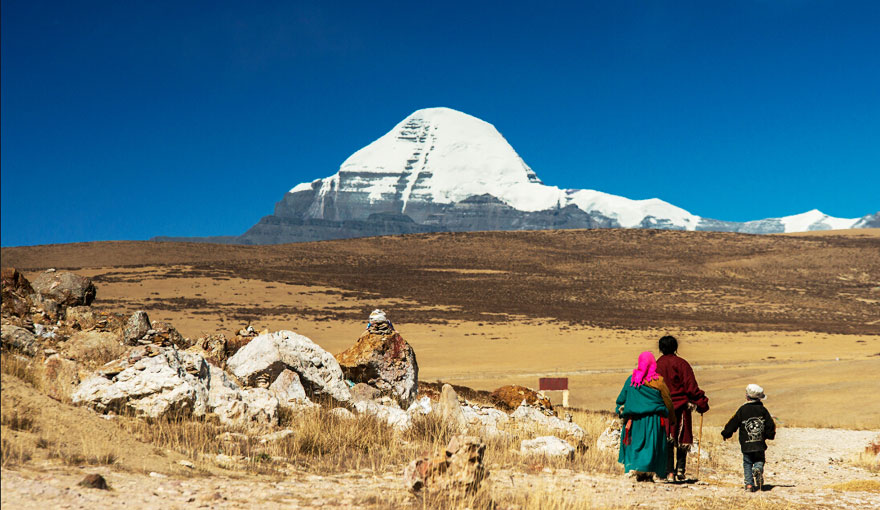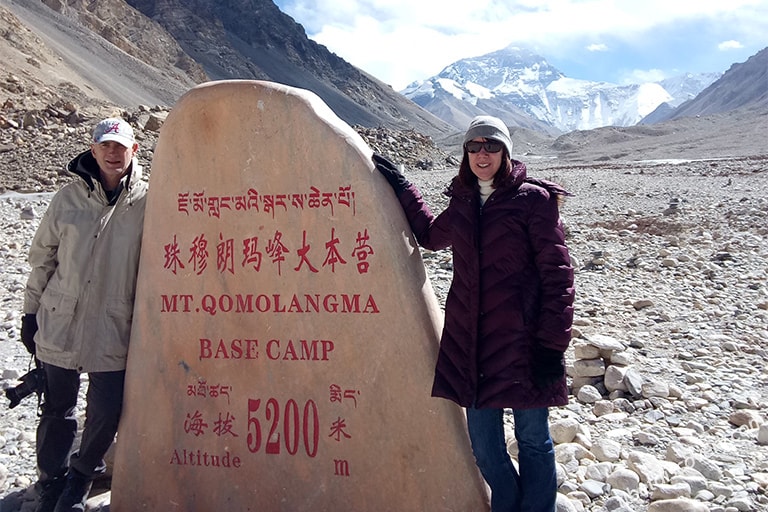There are two circumambulating circuits for Mount Kailash Yatra – the outer circuit centering on Mount
Kailash while the inner circuit focusesing on Mount Yinjietuo. The Buddhist legendary goes like that only the
people who have finished thirteen rounds of the out circuit are qualified for an inner kora. However, in the
year of horse according Tibetan calendar, one round Yatra is equal to thirteen rounds in the others years.
Therefore, if you have Mount Kailash Yatra in the year of horse, you can undertake another in the inner
circuit. The last year of horse is 2014 and the next year of horse is 2026.
Outer Mount Kailash Yatra
When we take about Mount Kailash Yatra, we always mean the outer kora. The outer circuit is long as 52km (or
49km without visiting monasteries). The Yatra starts from and ends at Darchen. The milestones include Dirapuk
Monastery (elv. 4080m), Drolma-la (elv. 5630m) and Zutulpuk Monastery (elv. 4835m). Because the physical
strength varies on different people, the pilgrims may spend one day, two days or three days on Mount Kailash
Yatra.
One day’s route demands the strong energy and superior stamina. It is only suitable for
the very experienced trekkers and local pilgrims with sturdy constitution. In order to complete the
Yatra smoothly, you are recommended to start at 5:00am, get to Dirapuk Monastery at 12:00pm, to Drolma-la at
16:00pm, back to Darchen at 22:00pm. The whole Yatra takes about 15~18 hours. In Ngari, the day breaks at
about 7:00am and it becomes dark at around 22:00.
Two days’ route, quite easier to finish, but still requires the good energy and sound body
free from High Altitude Sickness. Starting from Darchen at 9:00 on day one, the pilgrims can take about
1 hour to get to the peak and enjoy the colorful prayer flags, and another 1 hour to get to the pagoda. Then
trek along with the up-and-down road, and get to Dirapuk Monastery 3~4 hours later. On day two, climb to
Droma-la from 8:00am to 12:00pm, and then go down to the camp where you can have lunch. Then take about 2~3
hours to get to Zutulpuk Monastery and another 3~4 hours back to Darchen.
Three days’ route are available for all people with good health. Pilgrims can get to
Dirapuk Monastery and accommodate ther on Day 1, to Zutulpuk Monastery on Day 2 and return to Darchen on Day
3. Regardless of the religion, many tourists also take this route to have a lifetime long trekking.
Check the detailed information at Kailash Mansarovar Trekking.
Inner Mount Kailash Yatra
The Inner Circuit is close to Mount Kailash and pilgrims can admire a more wonderful sight of the holy
mountain. However, there are much fewer people undertaking inner Yatra. In addition to the Buddhist legendary,
another reason is that the road is very steep and full of stone riprap. The weather is always changeable and
pilgrims might encounter strong sunshine, heavily snow, hails and strong wind in a single day.
The inner kora is about 30-kilometer-long and one day is enough to complete it. Also starting from
Darchen, go along with river countercurrent from the north side of Darchen and then turn left at the
intersection. After you reach Selong Monastery, walk along the west of Mount Yinjietuo till the foot of
Mount Kailash where you can see the big icy swastika on its south face. After your worship, trace down from
the east face of Mount Yinjietuo and go back to Selong Monastery along the valley. Move east towards to the
5300-meter-high pass and reach Gyangdrak Monastery which is the first monastery in Kailash. After that,
walk back to Darchen.
You’d better think twice before leaving for an inner circuit since trekking over the cliffs and passes
to finish the inner circuit is never easy.
Lake Mansarovar Yatra
Lake Mansarovar is located 30km southeast to Mount Kailash, covering an area of over 400 square kilometers.
The road around Lake Mansarovar is in much better condition than Mount Kailash. The Mansarovar Yatra is a
lovely walk and you can enjoy the great lake view and wild nature. There are five monasteries around
the lake, namely Chiu Monastery, Langbona Monastery, Seralung Monastery, Trugo Monastery and Gossul Monastery.
There is no fixed starting point and terminal point of Mansarovar Yatra, but pilgrims usually start from Chiu
Monastery. The circuit of Mansarovar Yatra reaches to nearly 90km and it takes four days to accomplish
it usually.
Day 1: Chiu Monastery – Hor Qu, 6~8 hours
Starting from Chiu Monastery, you will walk clockwise about four hours to get to Langbona Monastery. Take a
rest there and then walk another fours to Hor Qu. On your way to Hor Qu, you will cross a marsh land, and
remember to keep a distance to the riverside. Hor Qu is one transportation hub in Ngari, and you can buy some
daily necessities there.
Day 2: Hor Qu ~ Seralung Monastery, 3~5 hours
Leaving Hor Qu, you can enjoy the amazing wetland view again. There are a large number of water birds there.
After you walk along with the wetland and go across a bridge, you will get to Serlung Monastery soon.
Day 3: Seralung Monastery ~ Trugo Monstery, 5~6 hours
On the third day, you need to walk about five hours or more along with the southern bank of Lake Mansarovar
to Trugo Monastery. Trugo means Bathing Head literally for it is an important place for ritual bathing.
Day 4: Trupo Monastery ~ Chiu Monastery
You will finish the longest trekking distance to back to Chiu Monastery on the last day.











 Karen
Karen Wonder
Wonder Jack
Jack Rita
Rita Johnson
Johnson Vivien
Vivien Wing
Wing Ariel
Ariel Leo
Leo Tracy
Tracy Evelyn
Evelyn April
April Phoebe
Phoebe Kelly
Kelly Shirley
Shirley Reya
Reya Juliet
Juliet Elk
Elk Samantha
Samantha Felix
Felix Sean
Sean